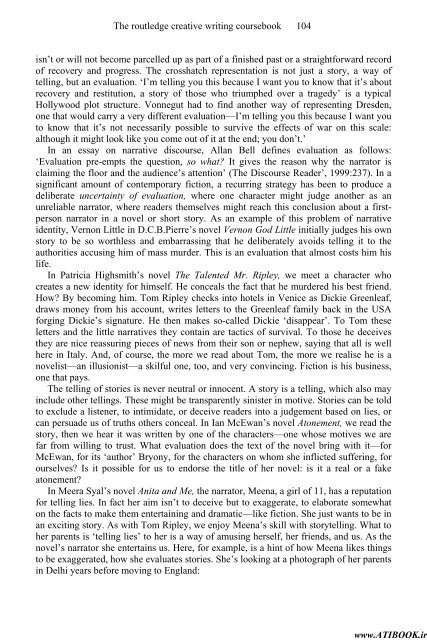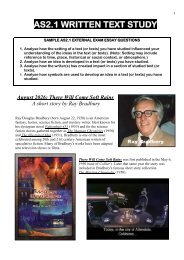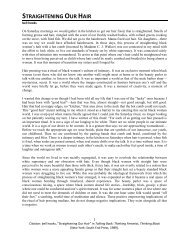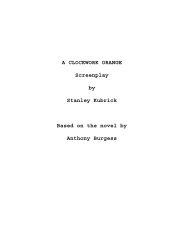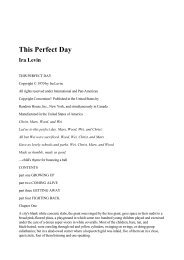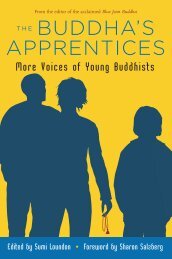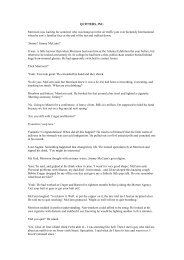9780415317856_the_routledge_creative_writing_coursebook
9780415317856_the_routledge_creative_writing_coursebook
9780415317856_the_routledge_creative_writing_coursebook
Create successful ePaper yourself
Turn your PDF publications into a flip-book with our unique Google optimized e-Paper software.
www.ATIBOOK.irThe <strong>routledge</strong> <strong>creative</strong> <strong>writing</strong> <strong>coursebook</strong> 104isn’t or will not become parcelled up as part of a finished past or a straightforward recordof recovery and progress. The crosshatch representation is not just a story, a way oftelling, but an evaluation. ‘I’m telling you this because I want you to know that it’s aboutrecovery and restitution, a story of those who triumphed over a tragedy’ is a typicalHollywood plot structure. Vonnegut had to find ano<strong>the</strong>r way of representing Dresden,one that would carry a very different evaluation—I’m telling you this because I want youto know that it’s not necessarily possible to survive <strong>the</strong> effects of war on this scale:although it might look like you come out of it at <strong>the</strong> end; you don’t.’In an essay on narrative discourse, Allan Bell defines evaluation as follows:‘Evaluation pre-empts <strong>the</strong> question, so what? It gives <strong>the</strong> reason why <strong>the</strong> narrator isclaiming <strong>the</strong> floor and <strong>the</strong> audience’s attention’ (The Discourse Reader’, 1999:237). In asignificant amount of contemporary fiction, a recurring strategy has been to produce adeliberate uncertainty of evaluation, where one character might judge ano<strong>the</strong>r as anunreliable narrator, where readers <strong>the</strong>mselves might reach this conclusion about a firstpersonnarrator in a novel or short story. As an example of this problem of narrativeidentity, Vernon Little in D.C.B.Pierre’s novel Vernon God Little initially judges his ownstory to be so worthless and embarrassing that he deliberately avoids telling it to <strong>the</strong>authorities accusing him of mass murder. This is an evaluation that almost costs him hislife.In Patricia Highsmith’s novel The Talented Mr. Ripley, we meet a character whocreates a new identity for himself. He conceals <strong>the</strong> fact that he murdered his best friend.How? By becoming him. Tom Ripley checks into hotels in Venice as Dickie Greenleaf,draws money from his account, writes letters to <strong>the</strong> Greenleaf family back in <strong>the</strong> USAforging Dickie’s signature. He <strong>the</strong>n makes so-called Dickie ‘disappear’. To Tom <strong>the</strong>seletters and <strong>the</strong> little narratives <strong>the</strong>y contain are tactics of survival. To those he deceives<strong>the</strong>y are nice reassuring pieces of news from <strong>the</strong>ir son or nephew, saying that all is wellhere in Italy. And, of course, <strong>the</strong> more we read about Tom, <strong>the</strong> more we realise he is anovelist—an illusionist—a skilful one, too, and very convincing. Fiction is his business,one that pays.The telling of stories is never neutral or innocent. A story is a telling, which also mayinclude o<strong>the</strong>r tellings. These might be transparently sinister in motive. Stories can be toldto exclude a listener, to intimidate, or deceive readers into a judgement based on lies, orcan persuade us of truths o<strong>the</strong>rs conceal. In Ian McEwan’s novel Atonement, we read <strong>the</strong>story, <strong>the</strong>n we hear it was written by one of <strong>the</strong> characters—one whose motives we arefar from willing to trust. What evaluation does <strong>the</strong> text of <strong>the</strong> novel bring with it—forMcEwan, for its ‘author’ Bryony, for <strong>the</strong> characters on whom she inflicted suffering, forourselves? Is it possible for us to endorse <strong>the</strong> title of her novel: is it a real or a fakeatonement?In Meera Syal’s novel Anita and Me, <strong>the</strong> narrator, Meena, a girl of 11, has a reputationfor telling lies. In fact her aim isn’t to deceive but to exaggerate, to elaborate somewhaton <strong>the</strong> facts to make <strong>the</strong>m entertaining and dramatic—like fiction. She just wants to be inan exciting story. As with Tom Ripley, we enjoy Meena’s skill with storytelling. What toher parents is ‘telling lies’ to her is a way of amusing herself, her friends, and us. As <strong>the</strong>novel’s narrator she entertains us. Here, for example, is a hint of how Meena likes thingsto be exaggerated, how she evaluates stories. She’s looking at a photograph of her parentsin Delhi years before moving to England:


